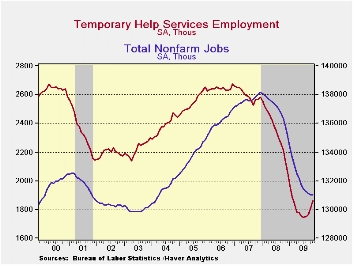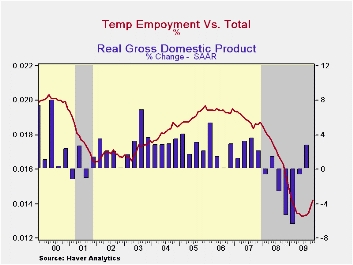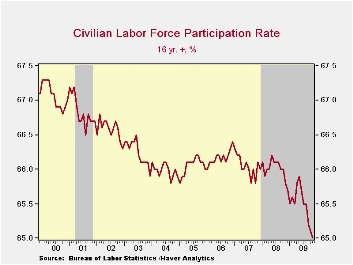 Global| Dec 07 2009
Global| Dec 07 2009Temp Hiring Bolsters Jobs & Portends Labor Market Improvement
by:Tom Moeller
|in:Economy in Brief
Summary
The November employment report indicated that the number of temporary help jobs grew by 52,400, the fourth consecutive month of increase. Since July temp employment grew by 116,900 (6.7%), a gain which outstripped the 95,500 (0.7%) [...]
 The
November employment report indicated that the number of temporary help
jobs grew by 52,400, the fourth consecutive month of increase. Since
July temp employment grew by 116,900 (6.7%), a gain which outstripped
the 95,500 (0.7%) four-month increase in health care employment, the
48,800 (1.9%) rise in social assistance payrolls, the 40,000 (0.8%)
gain in state gov't jobs as well as the few others.
The
November employment report indicated that the number of temporary help
jobs grew by 52,400, the fourth consecutive month of increase. Since
July temp employment grew by 116,900 (6.7%), a gain which outstripped
the 95,500 (0.7%) four-month increase in health care employment, the
48,800 (1.9%) rise in social assistance payrolls, the 40,000 (0.8%)
gain in state gov't jobs as well as the few others.
Not only has the growth in temp jobs been impressive, but as a leading indicator of full-time employment it bodes well for the job market. During the last two economic cycles temporary employment began growing a year or two before the recoveries in total employment, which both lagged the official end of the recessions.
 The ratio
of temp employment-to-total
payroll jobs also has value as a cyclical indicator. During the last
ten years there has been an 85% correlation between the ratio and real
GDP growth. Five years ago, a higher ratio near 2.0% was consistent
with 3.0% growth in real GDP. Temporary help jobs increased due to
workers' hours-worked flexibility and, for the most part, lower benefit
costs. Then, as economic growth eased, the ratio fell to its current
1.4%, the lowest level since 1994.
The ratio
of temp employment-to-total
payroll jobs also has value as a cyclical indicator. During the last
ten years there has been an 85% correlation between the ratio and real
GDP growth. Five years ago, a higher ratio near 2.0% was consistent
with 3.0% growth in real GDP. Temporary help jobs increased due to
workers' hours-worked flexibility and, for the most part, lower benefit
costs. Then, as economic growth eased, the ratio fell to its current
1.4%, the lowest level since 1994.
 Overall,
economic
recovery will bolster not only full-time employment, as usual, but temp
jobs as well. If the Consensus 3.0% growth forecast through the end of
next year is on the mark, temp employment should rise along with its
share of the total; indicating a greater number of workers re-entering
the workforce. That would turn-around the decline in the labor force
participation rate which recently has plumbed a 25-year low of 65.0%.
However, the "quality" of those new jobs likely will differ greatly
from the benefits of full-time employment.
Overall,
economic
recovery will bolster not only full-time employment, as usual, but temp
jobs as well. If the Consensus 3.0% growth forecast through the end of
next year is on the mark, temp employment should rise along with its
share of the total; indicating a greater number of workers re-entering
the workforce. That would turn-around the decline in the labor force
participation rate which recently has plumbed a 25-year low of 65.0%.
However, the "quality" of those new jobs likely will differ greatly
from the benefits of full-time employment.
Why do firms use temporary workers? from the Federal Reserve Bank of Chicago can be found here.
Today's speech titled by Frequently Asked Questions Fed Chairman Ben S. Bernanke is available here.
| Nonfarm Payrolls | November | October | September | Nov. '08 | 2008 | 2007 | 2006 |
|---|---|---|---|---|---|---|---|
| Temporary Help (000s) | 1,862.1 | 1,809.7 | 1,765.6 | 2,128 | 2,346.4 | 2,599.4 | 2,641.6 |
| Share of Total Jobs (%) | 1.42 | 1.38 | 1.35 | 1.57 | 1.71 | 1.89 | 1.94 |
Tom Moeller
AuthorMore in Author Profile »Prior to joining Haver Analytics in 2000, Mr. Moeller worked as the Economist at Chancellor Capital Management from 1985 to 1999. There, he developed comprehensive economic forecasts and interpreted economic data for equity and fixed income portfolio managers. Also at Chancellor, Mr. Moeller worked as an equity analyst and was responsible for researching and rating companies in the economically sensitive automobile and housing industries for investment in Chancellor’s equity portfolio. Prior to joining Chancellor, Mr. Moeller was an Economist at Citibank from 1979 to 1984. He also analyzed pricing behavior in the metals industry for the Council on Wage and Price Stability in Washington, D.C. In 1999, Mr. Moeller received the award for most accurate forecast from the Forecasters' Club of New York. From 1990 to 1992 he was President of the New York Association for Business Economists. Mr. Moeller earned an M.B.A. in Finance from Fordham University, where he graduated in 1987. He holds a Bachelor of Arts in Economics from George Washington University.






